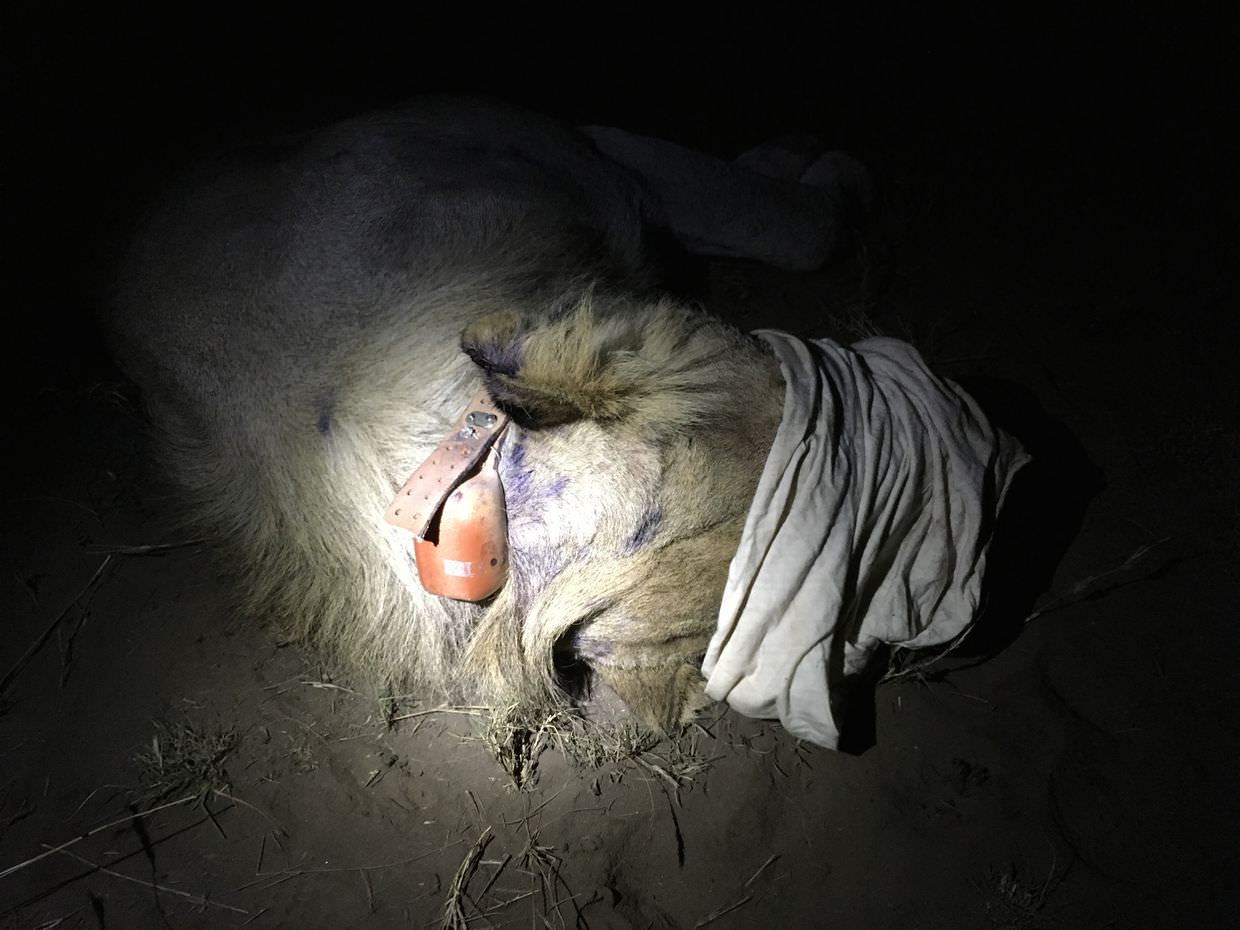2 weeks volunteering with Wildlife Act
After 2 wonderful weeks volunteering with Wildlife Act in iMfolozi I started my next 2-week stint with them, weeks 7 and 8 of a 12 week trip. Leaving iMfolozi, and heading out of Mtubatuba, I was taken north. A 2 hour drive on a minibus, stopping for a night in Zululand Rhino Reserve before continuing for two more hours, through Jozini, across its dam, and up to Tembe Elephant Park, right on the Mozambique border. My time here is also part of Wildlife Act’s “Endangered Species Conservation” project.
My volunteer group was 5 people, this time they were older; from oldest in iMfolozi I was now youngest, yet I stayed the responsible one with the emergency volunteer phone. I was joined by Lynn and Peter – two travelling companions from New Jersey, a zoologist and an entomologist specialising in mosquitoes; Lindsey, from Houston, US, and Joris, a dutchman who I’d share a cabin with. Our monitor was Hayden, a friendly and contemplative young guy; he’s a natural around animals. Occasionally we had elephant sessions with Leonard too, or ‘Leo’, a talkative guy, he loves to make or fix stuff, and he’s head of research here.
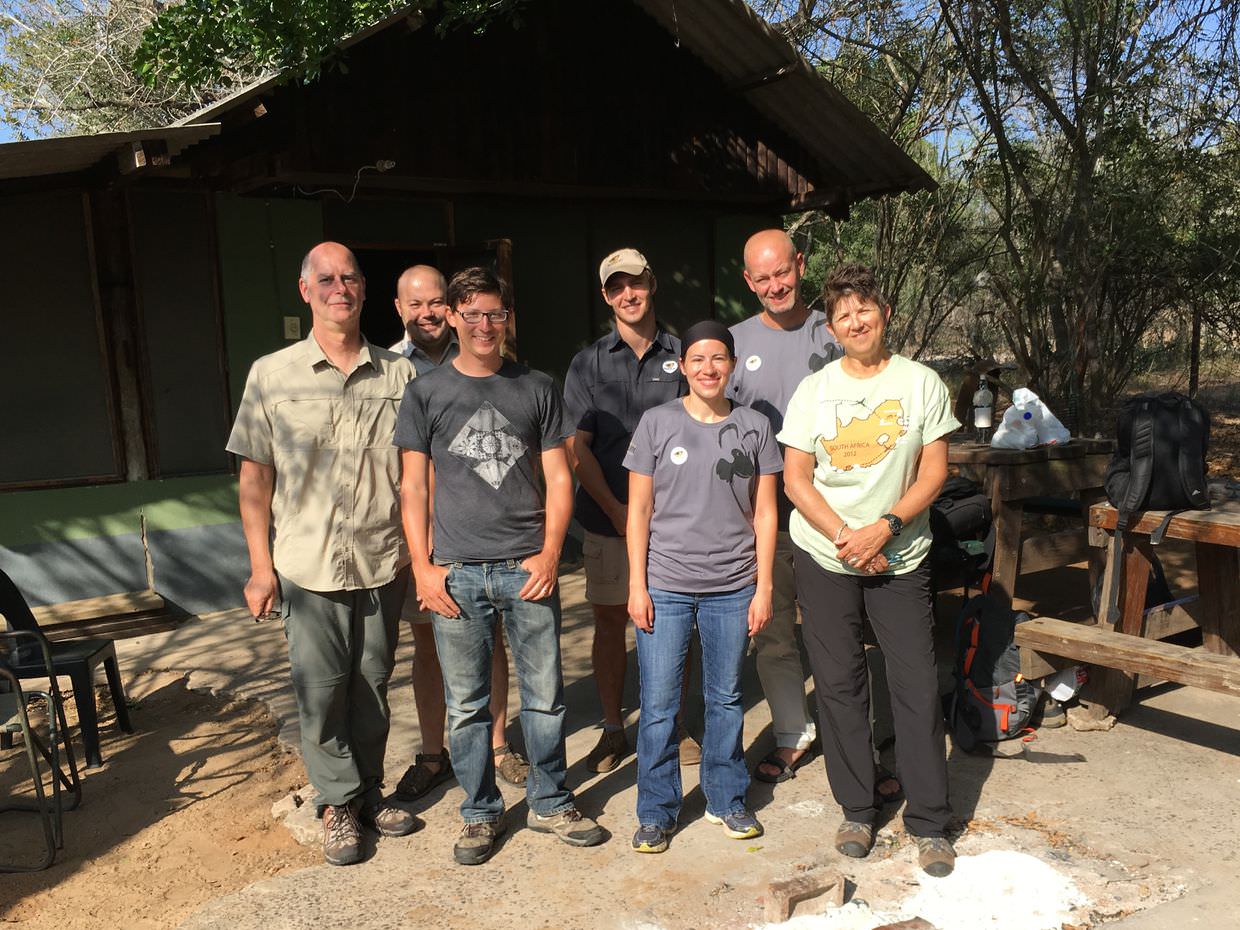
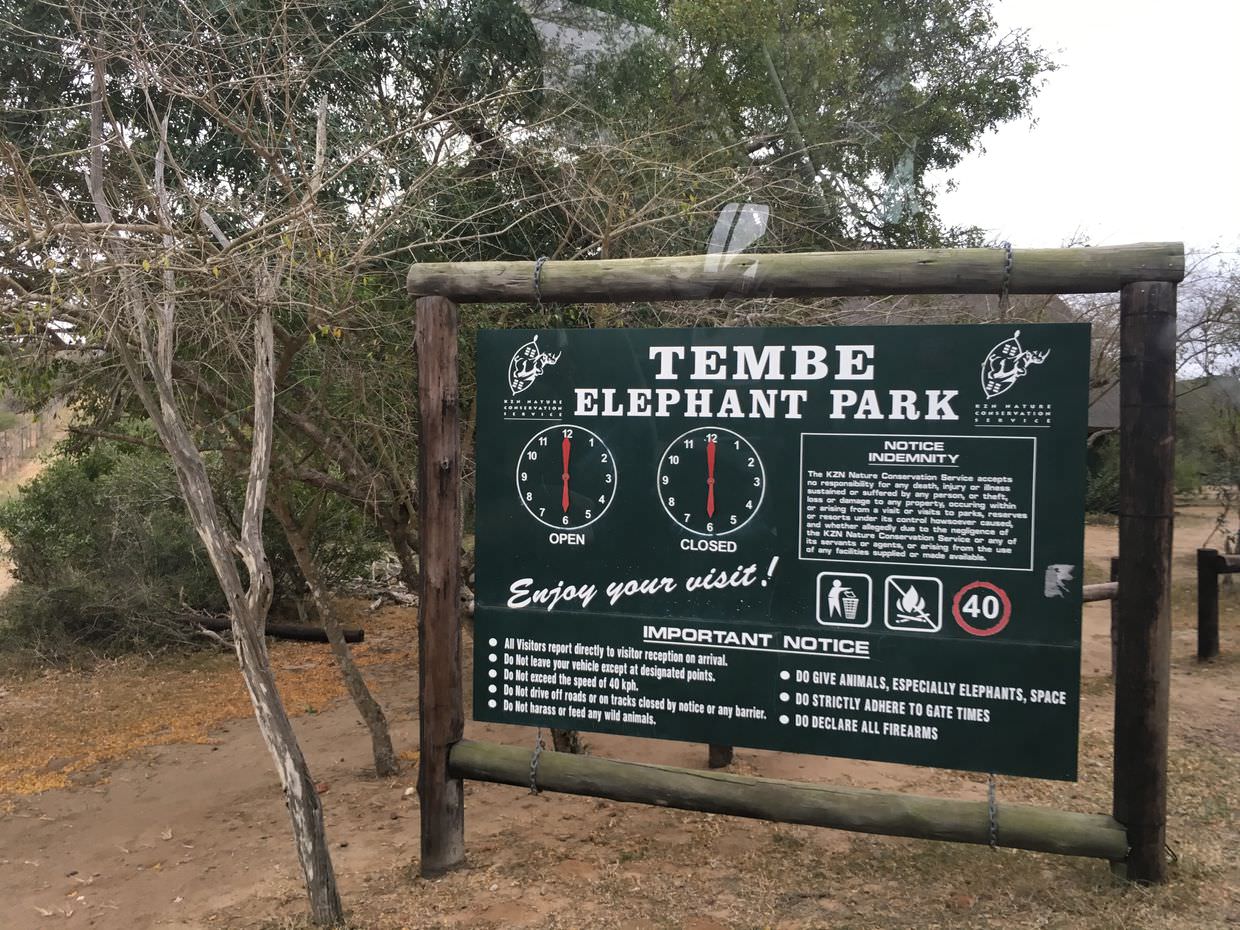
Tembe Elephant Park is very different to iMfolozi. Gone are the umbrella acacias and red dirt, they’re replaced with a unique and protected sand forest, growing from ancient sand dunes. The roads are made of sand, a sandy channel lined with trenches carved from the wheels of 4x4s. It’s like driving on a beach and four-wheel drive is essential, when leaving the confines of these trenches even the trucks slip and slide in the sand.
Lining the roads are rare and endemic sand forest species; like hardwood lebombo wattle (newtonia) trees, beautiful pod mahogany’s that grow up and out to create giant natural parasols and grey-barked false tambouti trees – bare at this time of year, save a few straggling yellow and green leaves. It all combines to create a picturesque palette of yellow, white and green; a landscape photographer’s dream – if only they could leave the vehicle and not get eaten.
Tembe was set up to protect suni (a type of tiny antelope), sand forest, and elephants fleeing civil war in Mozambique. It’s a smaller park than iMfoloze, and as volunteers we were more involved with some of the park’s management.
Wildlife Act volunteer camp
The camp here is almost luxurious when compared to iMfolozi. There’s power all the time, and there’s water too. The camp is for research; there are 5 wooden cabins each with two beds, a wardrobe and air-conditioning. It’s got aircon! There’s a large communal kitchen that doesn’t get too hot, a lounge-like area with very old garden furniture, an old TV and VHS player, and outdoor benches.
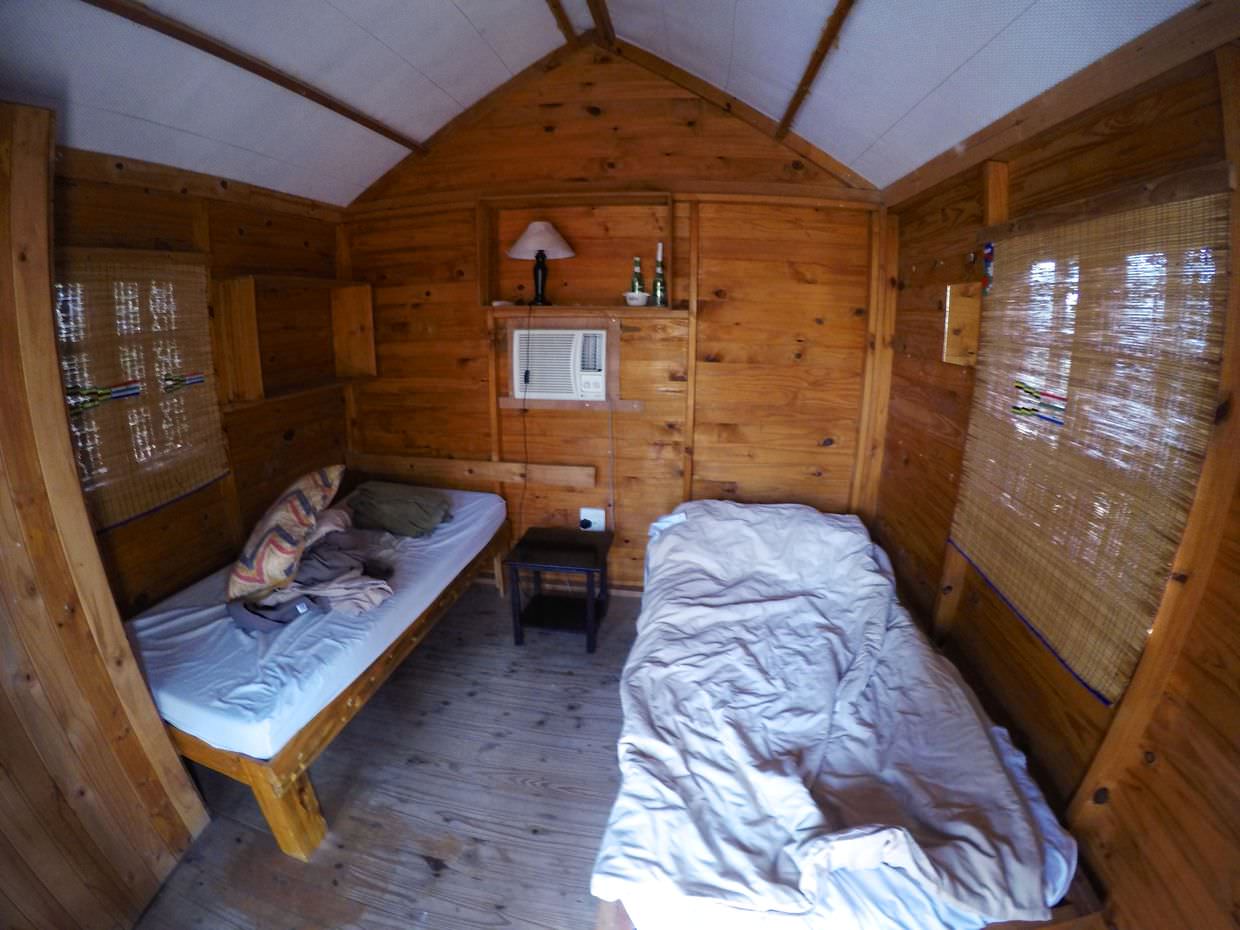
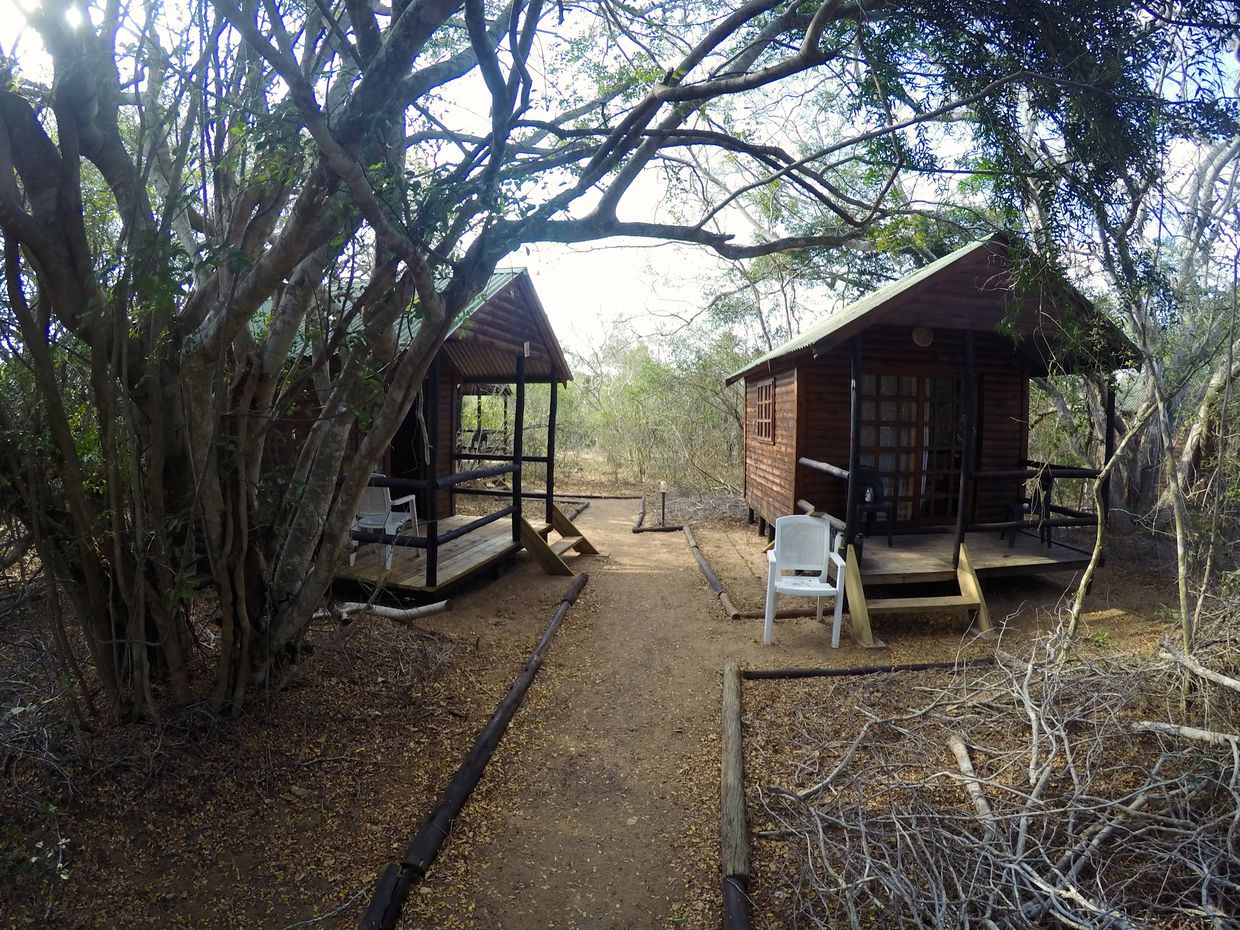
Two green bulbuls own the overlooking trees; they’re tame and are happy to come and eat from your hand, or take a bath besides you – sometimes they thief food too; Peter had cheese whipped from his hand. These birds have a taste for cheddar it seems. Sunbirds also frequent the flowers.
We also get the odd herd of nyala antelope passing through. They don’t mind us too much, and we can fill up the bird bath to attract them over. A mother and daughter were common visitors, and an inquisitive male watched me hang up laundry. Besides the washing line we also found a collared sunbird nest. This place has a washing machine, no hand-washing required, unlike other reserves. On the rooftops we could find vervet monkeys scuttling away – we were careful not to leave food or valuables out that they might pinch. There’s a shy squirrel that nips about the trees too. The camp is fenced with high-voltage electrics, to keep out the elephants.
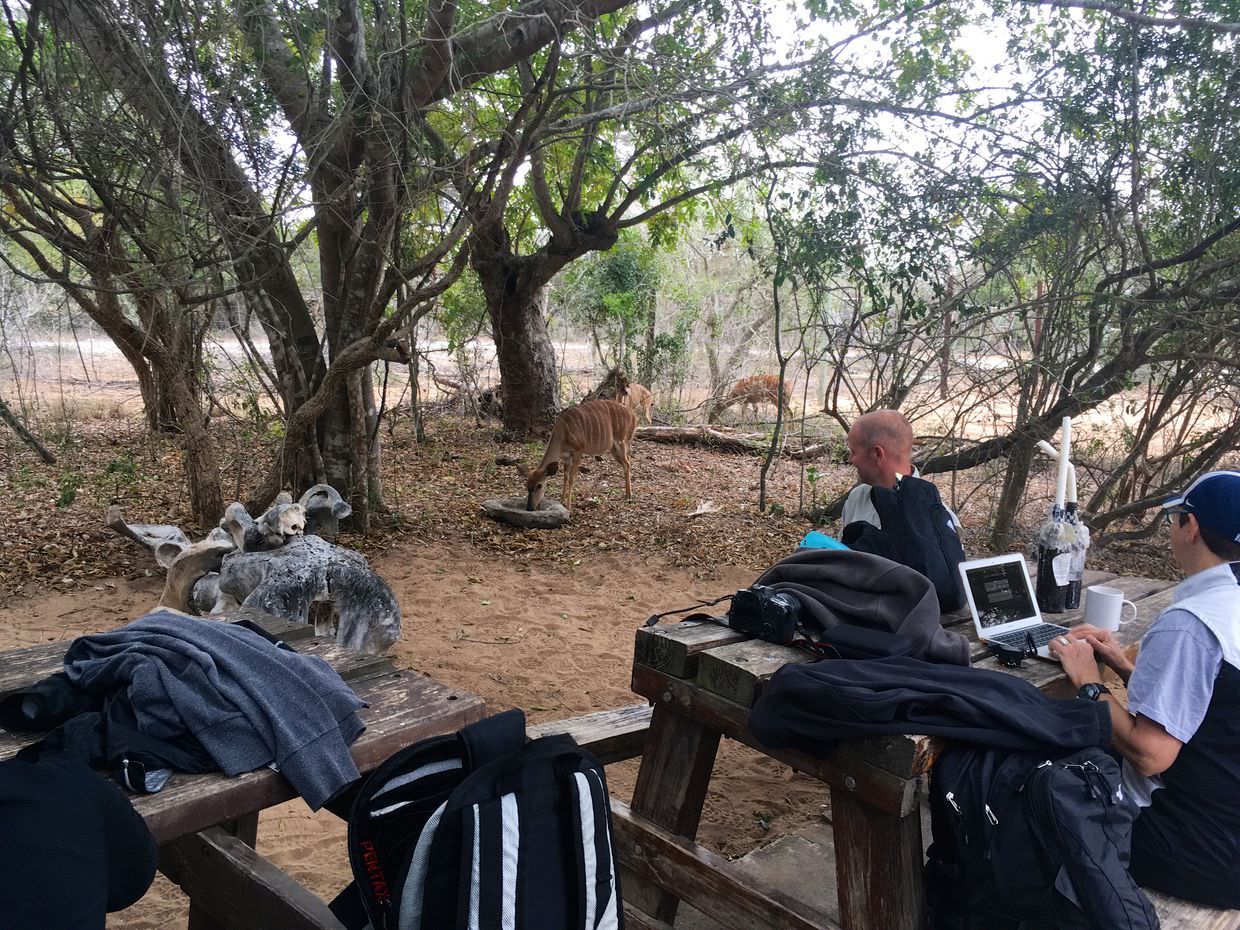
Day 1 – Thrown in at the deep end
The wild dog situation
We left Zululand Rhino Reserve early, and got to Tembe by 10am. Leo greeted us and showed us to our rooms. Hayden was out on patrol with two vets, trying to find a wild dog.
A pack of wild dogs had been consistently escaping the reserve. Fences built on sand are not difficult to circumvent if you’re a pack of dogs that loves to dig, especially when there’s incentive to get out and find food. Lions are dominating all the top hunting areas. When they escape they create problems in the community, with reports of livestock deaths – the park has had to pay out compensation, and the community has had enough; the dogs must go.
Cue a project to catch the entire dog pack and move them out to another park, probably one in Botswana. But catching wild dogs isn’t easy, even if one of them is collared and can be tracked. It certainly can’t be done in 3 days, the original timeframe.
A call-up is what parks do to catch game; a bait is set, the scent is spread and some dying animal noise is played – “calling up” the wild animals so they can be darted.
Before we arrived one of the dogs had been caught, and when the last volunteer group were here they used nets in a call-up to catch three more – though the collared dog, Elsa, had to be released to rejoin the pack so they could all be tracked. All but one of the dogs was then caught the night before we arrived; 5 dogs were now in the boma, and only the collared dog Elsa was still in the park.
This included a single puppy. The dogs had been denning, but weren’t successful, and all but one of the new pups had died. The puppy was caught by hand by one of the vets. Hayden was out when we arrived trying to dart the last dog, Elsa the collared one; he wanted to finish the job while the vets were around. She didn’t play ball, her signal couldn’t be found and no darts were fired. The vets were staying in one of the cabins, they had one more night to try.
This dog project played an integral part in our volunteer duties; we’d visit them every morning and night to check on them, to check that they hadn’t escaped, that there were so signs of an escape attempt, to check that holes they’d dug were filled in, and to try and habitualise the dogs (both in and out of the boma) to further call-ups – by providing bait which had no negative consequence for them. This would make catching Elsa easier and when it came to transfer day, the dogs in the boma could be more easily darted.
Hayden arrived and introduced himself, he looked tired; these guys are all working extremely hard to sort out these dogs. There was an unused leg of nyala in the truck.
Elephant session with Leo
Leo took us out at 11am for our first Tembe session. We travelled at snail’s pace, stuck behind a driver struggling with his 4x4 in the sand. He turns left, we speed up and search for elephants.
We find our first elephant bull standing besides the road, nonchalantly pulling branches off a tree. We stopped close; in iMfolozi I’d have been worried, but the elephants here are different, they seem, on the whole, calmer and of a nicer disposition. It also helped being with Leo, he knows the elephants, he knows how grumpy or curious they can be. We pass him and continue to the hide.
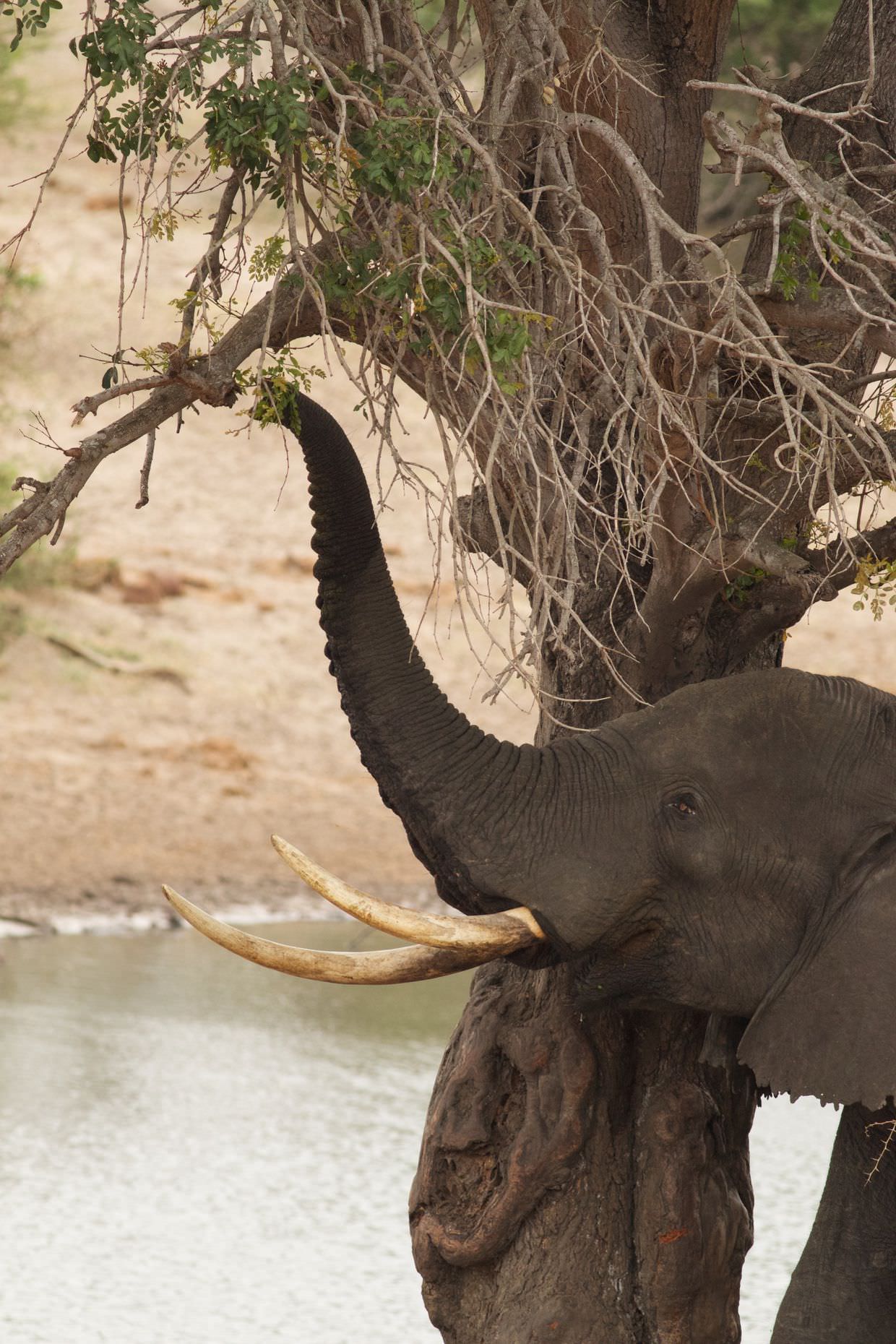
Mahlasela hide looks over a natural waterhole that’s artificially pumped with water during drought. It’s streamed live on a web cam. There are elephant bulls drinking and frolicking in the mud, small herds of nyala cautiously approach to drink, storks hang around at the edges. On our way out we pass the elephant again, and a group of young giraffe who stare at us inquisitively.
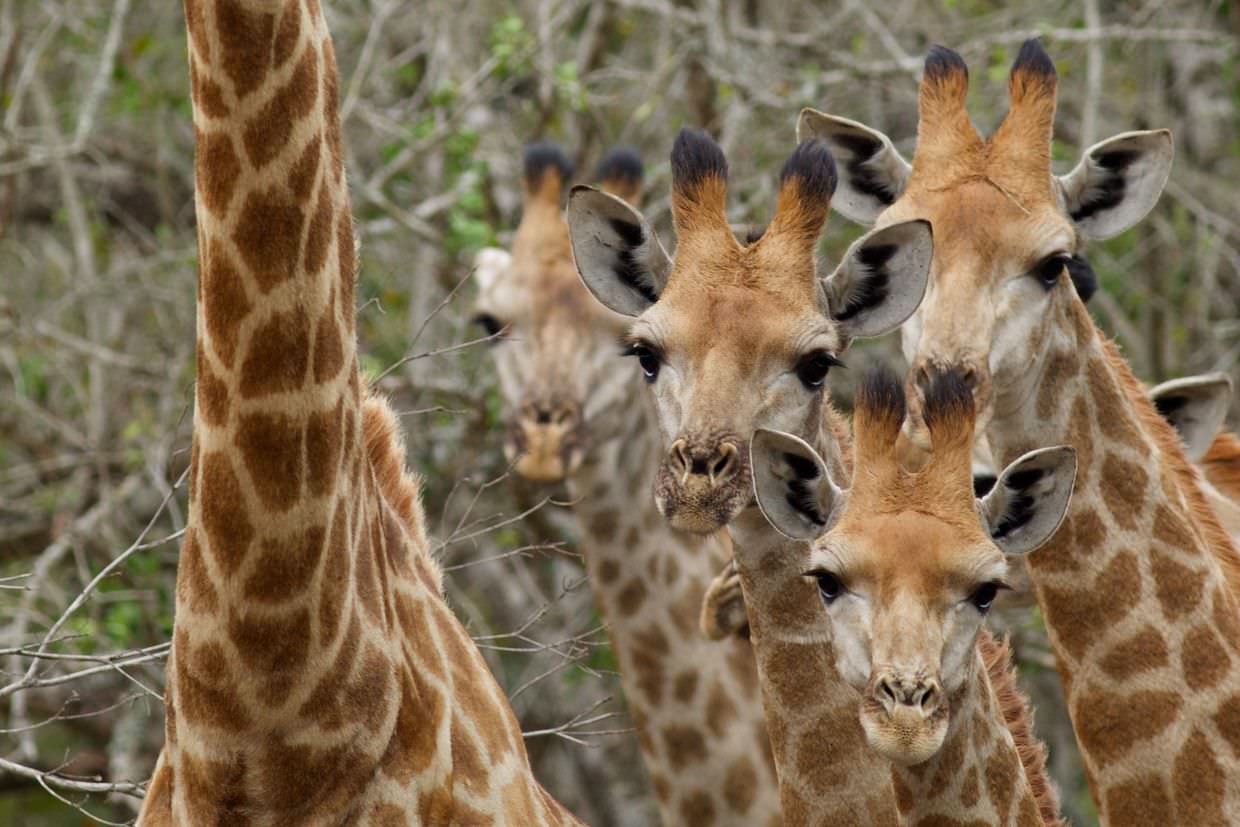
Collaring a lion
When we arrived Hayden said there’d be a lion call-up tonight. For a lion call-up you need a covered vehicle – lions mustn’t associate humans with food – that way people die and lions get shot. Hayden was trying to get us one. I was nervous it wouldn’t happen, or that we’d miss it; we missed out on a similar one in iMfolozi for those reasons, I tried to keep my expectations in check. By the evening everything was sorted and the call-up was on. It’d be all 5 of us, our monitor Hayden, Leo, a vet and two trainee vets.
The lions were seen near the hide; we would set up the bait nearby and wait there until they’d fed and been darted, then we’d go down and watch the vets do their thing. That’s if the lions took the bait and all went to plan.
The bait was a dead male nyala. It’s lucky none of us were vegetarian. This got a bit grim. From the back of the truck we dragged out the carcass and tied it to a pole with chains. Two metal screens were put up on either side, forcing any feeding animal to look away from the trucks – it makes darting them easier and safer. To spread the scent Hayden gutted the nyala, tied the guts into a neat ball, chained them to a truck and dragged them around the roads near the hide; this would hopefully tempt the lions in. Quite the first impression.
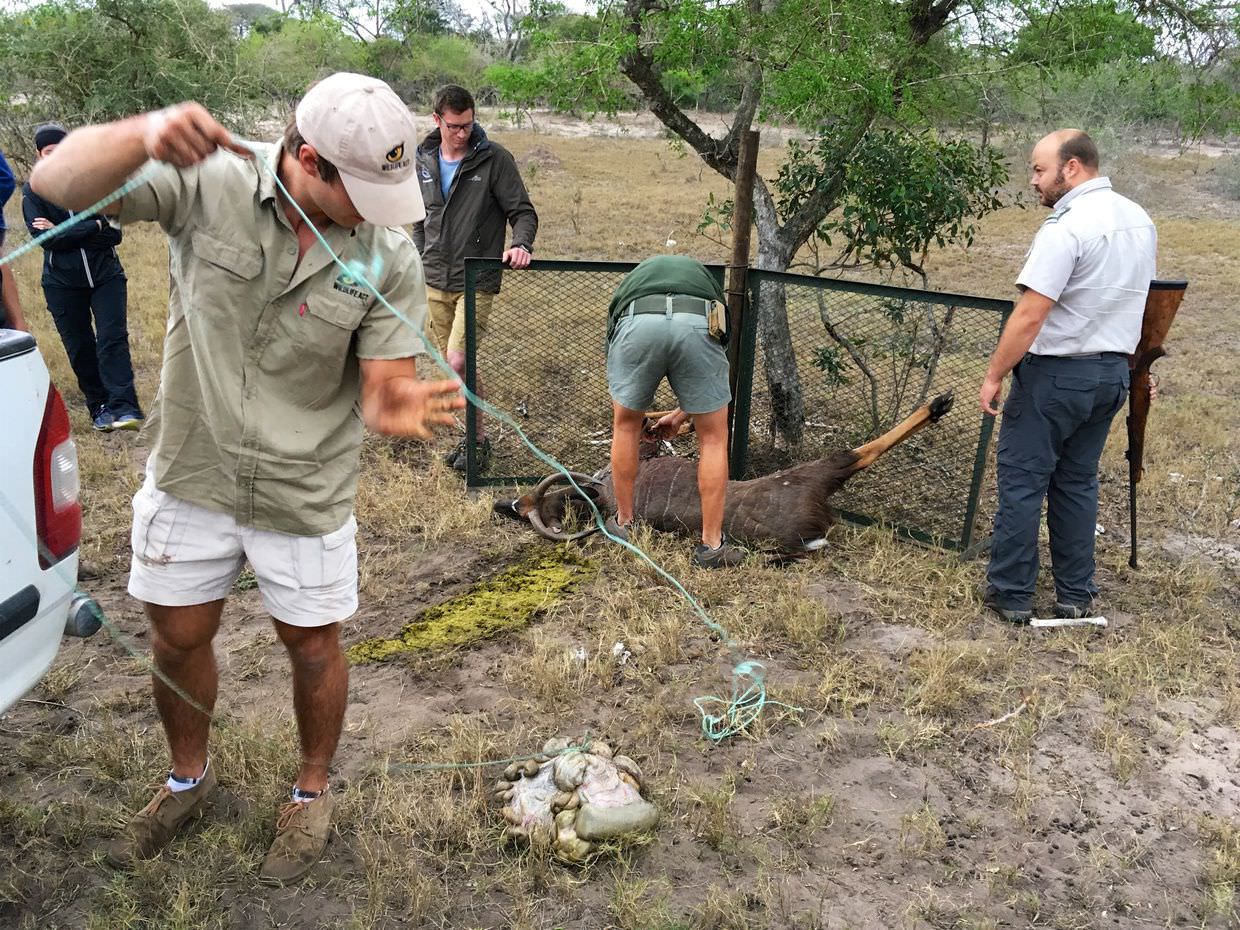
Leo stood guard with his rifle; getting off the truck is dangerous, and when people are on the ground working someone needs to be on lookout. We scanned for lions with the telemetry to double check none were close.
With the bait ready Leo got out his homebrew speakers which we hooked up to the car battery. It would play some very loud noises of a dying wildebeest. We left for the hide.
3 hours we waited; day turned to night, animals came and went. The night was warm, and the hide was comfortable. The whining painful noise of the dying wildebeest blasted out, it died over and over again. Without warning three lions appeared; a female and two sub adult males. Every 40 minutes or so the dying wildebeest track gets paused; it stops so vets can have a break from the audio torment, right now it wasn’t playing. Leo radios in, and the track kicks back on - the wildebeest is dying again. All three lions look up, they stop what they’re doing, and leave; they know this means an easy meal and they leave on a mission. From the hide we wait patiently, we need the lions to take the bait, one needs to be darted and the others need to flee.
A radio call; a sub adult was darted. We’re on our way. We rush back to the truck and clamber in, now we’re back at the bait site, pulled-up alongside the trainee vets, engines off, lights off. One sub-adult male was darted, but we can’t begin because the others came back; Hayden and the vet are nearby.
In the dark of the covered truck we wait nervously, windows open. There’s a flash, another dart shot; through the trees we see only the headlamps and brake-lights. What’s happening? Then a radio; success, two sub-adult lions darted, the female mother has fled.
It takes 10 minutes for the sedative to take affect. Leo and the trainee vets bring the sleeping lions over on the back of a truck. We’re in a wide open space, no animals can ambush us here. With the two lions on the ground, their eyes covered by a cloth, we drive all three trucks around them, boxing them and us in – for safety. Lights on, engines running; if anything comes our way we can make a speedy getaway.
Time to act; against the whirr of the diesel engines and under flashlight the vets begin. We get out and watch. At any time two of us keep lookout, rotating high powered beams, inspecting bushes for cat’s eyes, listening out for elephants. Leo clutches his rifle. Meanwhile the vets administer antidotes for the dart sedatives, they take blood and hair samples to test for diseases, check the cats’ health, and prepare a collar. Every now and then a vet taps each lion’s ears, looking for reflex responses, making sure they aren’t waking up.
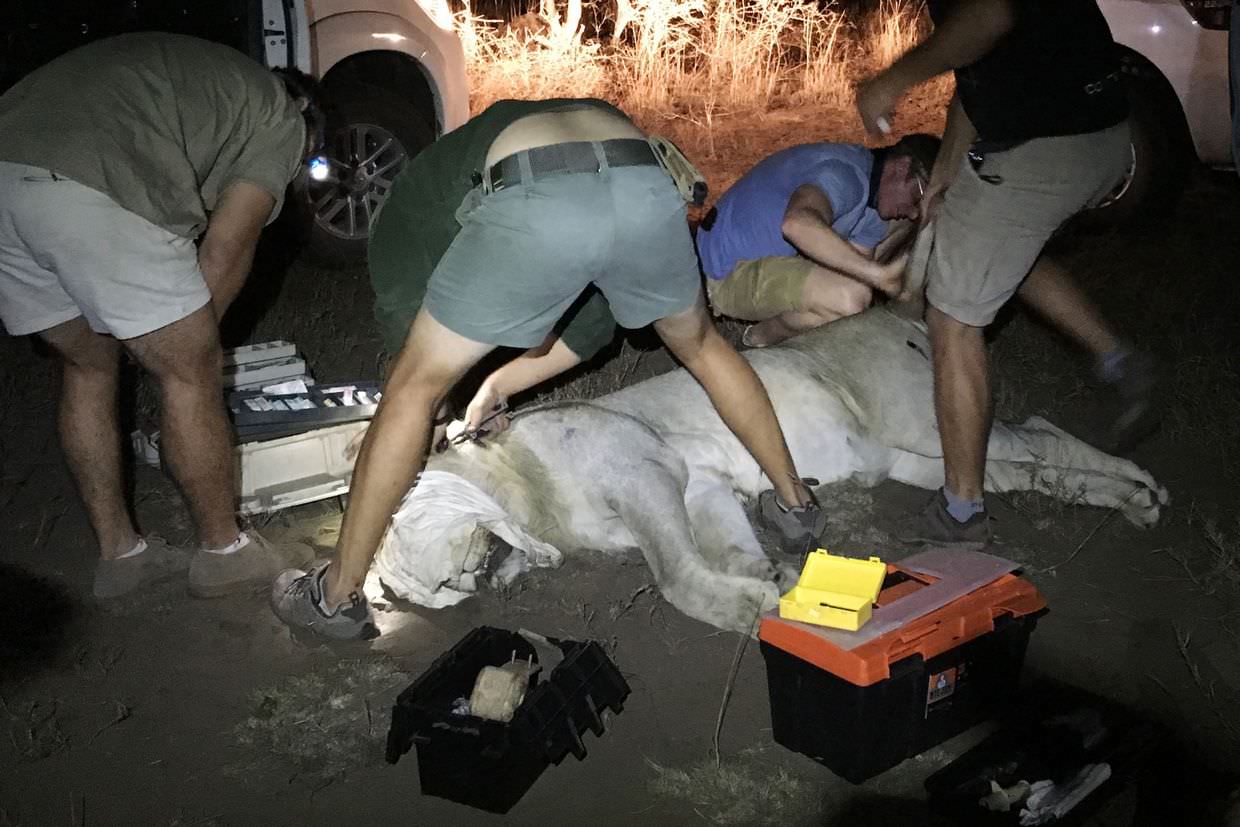

The lions are huge, their paws as big as my head, their body’s weigh over 200kg. I put my hand on their warm belly and feel them inhale and exhale, their fur is wiry. What an unbelievable experience. Us volunteers stand in awe, trying not to get in anyone’s way, thankful simply to be here, shining torches when the vets need more light.

“The mother is watching us”, in the bushes a set of cat’s eyes. She’s hanging around, clearly concerned for her sons, but she doesn’t approach. It’s unnerving to be standing in the dark knowing there’s an anxious lion watching you. But the work is wrapping up.
The collaring took half an hour; now one sub adult male has a GPS store-onboard collar, which also emits a VHF radio beep; we can track this pride’s movement and find them with telemetry. Job done. We head for home, its been a long but incredible day. Hayden and the vet stay with the lions; to make sure nothing happens while they sleep, and that they wake safely. In the morning we’d try and track them.
